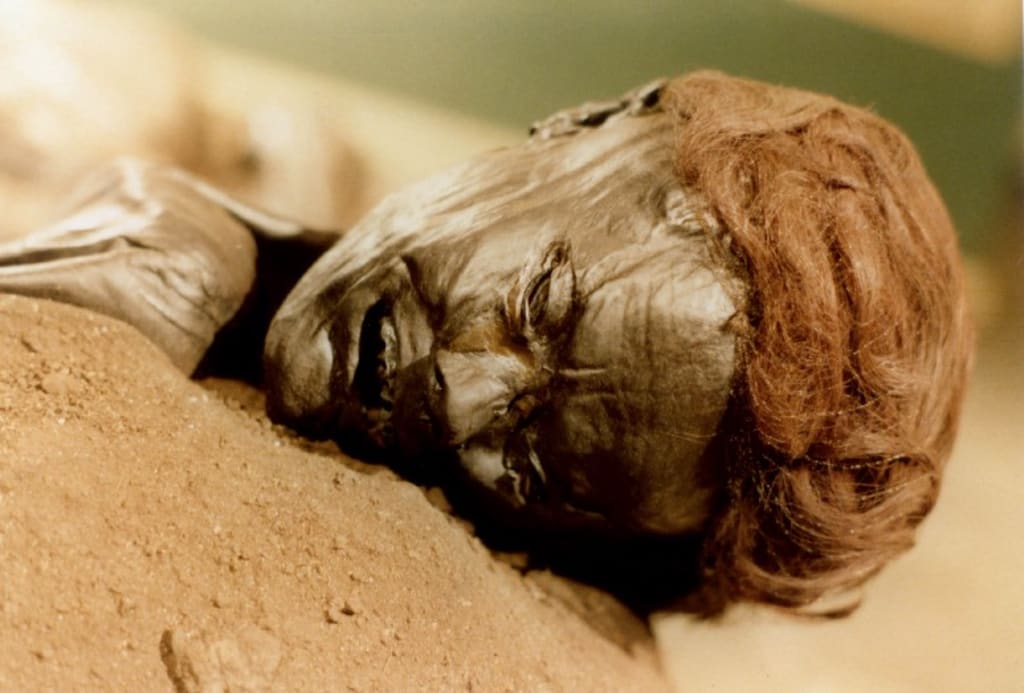
Graubelle Man
The Graubelle Man bog body, dating back to the Iron Age in the late 3rd century BC, was found in a Denmark bog in 1952 by a team of Danish peat cutters. His hair color is due to sphagnan (a polymer that oozes from dead sphagnum moss) dyeing it red over time. It is the same polymer responsible for the skin turning leather-like.
Sphagnum moss can be found blanketed on top of bogs, which are wetlands of peat (aka turf), dead plant material, and other mosses. They can grow close together so tightly packed that they form hummocks, which is why human corpses can be preserved in bogs for thousands of years, as well as their skin, hair, clothes, and even their stomach contents.
Look at the astonishing detail of the ancient corpse of someone who died over 2,300 years ago! It even shows the wrinkles on his face and the hair still on his head. This is such a remarkable display of ancient human history.
And, no, that’s not a toupee the mummified corpse is wearing. It’s his real hair that’s been preserved, along with the rest of his body, by a natural preservation process from sphagnum moss (aka peat moss) combining with low temperature, highly acidic water, and a lack of oxygen, which is also the reason his skin is leathery and tea-colored.


Archaeological examination reveals that Graubelle Man may have been a victim of human sacrifice, which was likely a normal ritual of his time. His cause of death was having his throat cut from ear to ear, based on evidence from his wounds showing that his esophagus and trachea had been severed. He was about 30 years old at the time of his death.

The preservation of this bog body is amazing! Seeing this much detail after 2,300 years is mind-boggling.
After he was killed, his corpse was thrown into the bog for disposal or maybe preservation. It's interesting to wonder if the people of that time knew that the bog would preserve the corpse. But whether they knew it or not, bog bodies enter natural preservation, as this one did for more than two millennia.
Another Bog Body Discovered
The wetlands in Northern Europe have proven to be the graves of many ancient bog mummies. Over 200 Iron Age era bog body discoveries have been made in Denmark alone. Another one in Jutland, where the Graubelle Man was discovered, is the Tollund Man.

Tollund Man
The bog body named Tollund Man was formed from the corpse of a man from the 4th century BC in the Pre-Roman Iron Age. It was determined that he was between 30 and 40 years old when he died. He was also discovered by peat cutters who found him in 1950 on the Jutland, Denmark peninsula. A local murderer had gone missing during this same time, and the bog body looked so fresh to them, they thought it was that murderer.

Look how magnificent this is. It looks like a work of art created by a sculptor, but knowing that this is the actual head of an ancient human is awe-inspiring. The detail is remarkable with his hair, hat, and even the wrinkles on his face being so well-defined.

Notice how well-preserved his features are! He's also over 2,300 years old and even his hat, made of sheepskin and wool, has been exceptionally preserved. Just like Graubelle Man, he appears to be a victim of human sacrifice, but his cause of death was by hanging, and his body was buried in a fetal position, which suggests he was ritualistically hanged as a sacrifice to the gods, instead of being executed for being a criminal. The rope is still around his neck!

The x-ray and autopsy performed on Tollund Man in 1950 revealed that all of his organs, including his brain, were amazingly intact. One of his most recent examinations was in 2015, and it included specialists in ancient DNA attempting to get a DNA sample from his femur, but they were not successful.
Bog Bodies Tell Stories
Peat bogs and the bodies that have been found in them are some of the most awesome archeological finds that give us valuable information about the lives of ancient humans.
The bogs are located in European countries, including Denmark, Ireland, and the United Kingdom, and many bog bodies have been discovered over a period of more than 100 years. One of the most interesting parts of bog body examinations is that some of them are so well preserved that they were able to have their fingerprints taken.
Some of the information that scientists have pieced together from examining these ancient human remains shows that people in the Iron Ages carried out activities similar to modern humans. They had trade networks, traveled, and collaborated with different cultures. And by examining stomach contents, scientists have also discovered that they ate mostly plants in warmer months and meat in colder months. They also made tools, weapons, wool, and leather and lived life back in these Paleolithic times much like we do today.
About the Creator
Audrey M.
I love to read and write about many interesting topics.






Comments
There are no comments for this story
Be the first to respond and start the conversation.